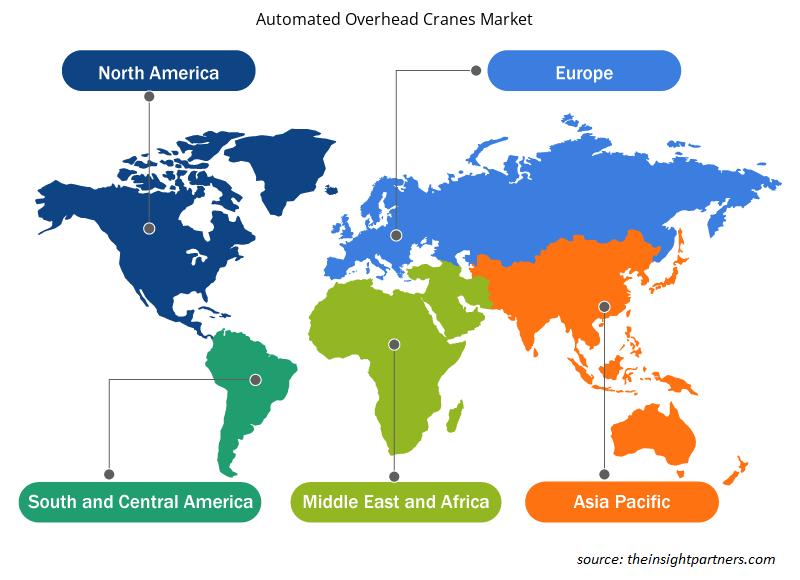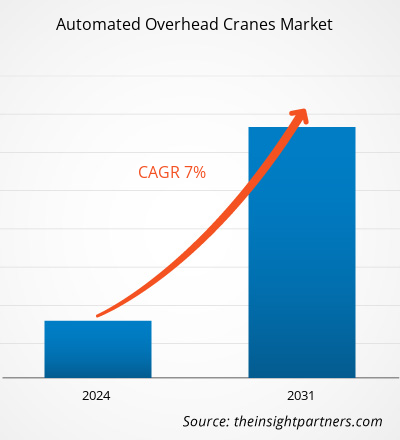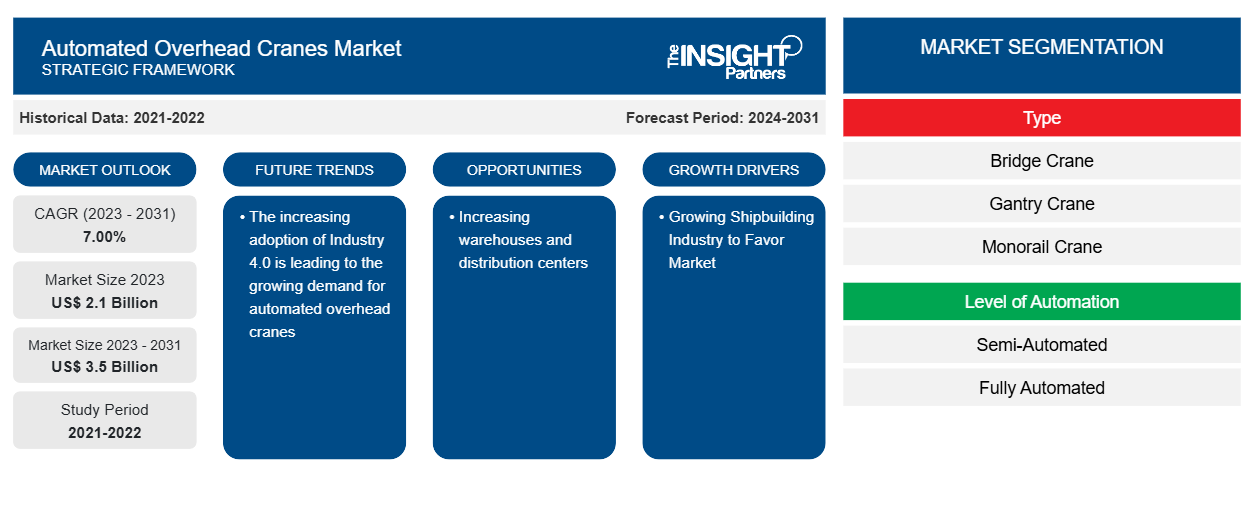Si prevede che il mercato delle gru a ponte automatizzate raggiungerà i 3,5 miliardi di dollari entro il 2031, rispetto ai 2,1 miliardi di dollari del 2023. Si prevede che il mercato registrerà un CAGR del 7,00% nel periodo 2023-2031. La crescente adozione dell'Industria 4.0 sta portando alla crescente domanda di gru a ponte automatizzate. Queste gru sono ulteriormente implementate con tecnologia intelligente che fornisce dati approfonditi, che aiutano ulteriormente nelle operazioni efficaci della tecnologia dell'Industria 4.0. Tale adozione dell'Industria 4.0 è destinata a rimanere una tendenza chiave nel mercato.
Analisi di mercato delle gru a ponte automatizzate
Gli stakeholder nel mercato delle gru a ponte automatizzate includono fornitori di componenti per gru a ponte automatizzate, produttori di gru a ponte automatizzate e utenti finali. La presenza di un gran numero di fornitori di componenti, tra cui telai per carrelli , cavi/funi, ruote per ponti, paranchi, rotaie per piste di decollo e altri produttori, facilita i produttori di gru a ponte automatizzate nel soddisfare le richieste dei rispettivi clienti. I fornitori di componenti per gru a ponte automatizzate stanno aumentando le loro capacità produttive per soddisfare la crescente domanda di produttori di gru a ponte automatizzate. Poiché i produttori di gru a ponte automatizzate lavorano costantemente in sincronia con i fornitori di componenti e con gli utenti finali, ciò li aiuta a comprendere le richieste degli utenti finali e a sviluppare componenti avanzati. Hanno anche vari distributori distribuiti in vari paesi e regioni, che forniscono anche supporto di servizio agli utenti finali.
Panoramica del mercato delle gru a ponte automatizzate
Gli operatori del settore sono piuttosto scettici riguardo all'investimento in soluzioni automatizzate avanzate che comportano un elevato CAPEX iniziale e costi associati a costanti aggiornamenti e manutenzione nella seconda parte a causa dei loro vincoli di budget. I settori che stanno adottando gru a ponte automatizzate richiedono in anticipo fornitori di soluzioni ben istruiti e competenti sulle complessità delle sue implementazioni, come il costo associato alla produzione di gru a ponte automatizzate e al suo rinnovo, manutenzione, spese di servizio, formazione e consulenza, tra gli altri. Poiché questi sono altamente critici per un'azienda, anche una piccola carenza può comportare un impatto finanziario significativo. Inoltre, i proprietari di piccole e medie imprese in diversi settori verticali del settore continuano a limitare la crescita del mercato, a causa del loro budget limitato per i macchinari industriali . Inoltre, si prevede che anche il mercato sensibile al prezzo, come alcuni paesi in Asia e nelle regioni africane, influenzerà negativamente l'adozione di gru a ponte automatizzate, a causa di problemi di budget e della mancanza di consapevolezza tra il suo personale industriale. Ostacolando così la crescita del mercato delle gru a ponte automatizzate in tutto il mondo.
Personalizza questo report in base alle tue esigenze
Riceverai la personalizzazione gratuita di qualsiasi report, comprese parti di questo report, o analisi a livello nazionale, pacchetto dati Excel, oltre a usufruire di grandi offerte e sconti per start-up e università
-
Scopri le principali tendenze di mercato in questo rapporto.Questo campione GRATUITO includerà analisi di dati che spaziano dalle tendenze di mercato alle stime e alle previsioni.
Driver e opportunità di mercato per le gru a ponte automatizzate
La crescita dell'industria cantieristica favorisce il mercato
L'industria cantieristica è in crescita grazie all'aumento del trasporto marittimo. Secondo i dati pubblicati dalla National Oceanic and Atmospheric Administration nel 2023, la costruzione di navi e imbarcazioni ha registrato un tasso di crescita del 15% dal 2020. Inoltre, l'industria cantieristica cinese ha completato la consegna di 38 milioni di tonnellate di portata lorda di navi e imbarcazioni, con una crescita del 12% dal 2022. Un tale aumento nell'industria cantieristica sta portando a una maggiore domanda di gru a ponte automatizzate, guidando in ultima analisi il mercato.
Aumento dei magazzini e dei centri di distribuzione
Gli e-retailer ora sono più impazienti di aprire magazzini nelle città di livello II e III. Pertanto, la domanda di gru a ponte automatizzate nei magazzini e nei centri di distribuzione per il sollevamento di attrezzature pesanti e la movimentazione dei materiali aumenterà. La gru da magazzino di solito è composta da una gru a ponte monotrave, una gru a ponte bitrave e una gru a cavalletto elettrica per scopi di sollevamento. La maggior parte dei magazzini e dei centri di distribuzione utilizza gru a ponte automatizzate con una capacità di sollevamento di 1 tonnellata, 3 tonnellate, 5 tonnellate e 10 tonnellate fino a 100 tonnellate.
Analisi della segmentazione del rapporto di mercato delle gru a ponte automatizzate
I segmenti chiave che hanno contribuito alla derivazione dell'analisi di mercato delle gru a ponte automatizzate sono tipologia, livello di automazione e settore.
- In base al tipo, il mercato delle gru a ponte automatizzate è suddiviso in gru a ponte, gru a cavalletto, gru monorotaia, gru a braccio e altre. Il segmento delle gru a ponte ha detenuto una quota di mercato maggiore nel 2023.
- In base al livello di automazione, il mercato è segmentato in semi-automatico e completamente automatizzato. Il segmento semi-automatico deteneva la quota maggiore del mercato nel 2023.
- In termini di settore, il mercato è diviso in manifatturiero, cantieristica navale, metalli e acciaio e altri. Il segmento manifatturiero ha detenuto una quota significativa del mercato nel 2023.
Analisi della quota di mercato delle gru a ponte automatizzate per area geografica
L'ambito geografico del rapporto di mercato sulle gru a ponte automatiche è suddiviso principalmente in cinque regioni: Nord America, Asia Pacifico, Europa, Medio Oriente e Africa, e Sud e Centro America.
La regione Asia-Pacifico ha dominato il mercato globale delle gru a ponte automatizzate. L'Europa ha rappresentato la seconda quota di mercato più grande. La Cina è emersa come uno degli hub manifatturieri a livello globale. Pertanto, il paese è diventato uno dei fornitori più importanti di attrezzature a basso costo. Inoltre, l'industria cantieristica ha assistito a una forte crescita negli ultimi anni, il che sta generando ulteriori opportunità redditizie per il mercato.
Approfondimenti regionali sul mercato delle gru a ponte automatizzate
Le tendenze regionali e i fattori che influenzano il mercato delle gru a ponte automatiche durante il periodo di previsione sono stati ampiamente spiegati dagli analisti di Insight Partners. Questa sezione discute anche i segmenti e la geografia del mercato delle gru a ponte automatiche in Nord America, Europa, Asia Pacifico, Medio Oriente e Africa e America centrale e meridionale.

- Ottieni i dati specifici regionali per il mercato delle gru a ponte automatizzate
Ambito del rapporto di mercato sulle gru a ponte automatizzate
| Attributo del report | Dettagli |
|---|---|
| Dimensioni del mercato nel 2023 | 2,1 miliardi di dollari USA |
| Dimensioni del mercato entro il 2031 | 3,5 miliardi di dollari USA |
| CAGR globale (2023-2031) | 7,00% |
| Dati storici | 2021-2022 |
| Periodo di previsione | 2024-2031 |
| Segmenti coperti |
Per tipo
|
| Regioni e Paesi coperti |
America del Nord
|
| Leader di mercato e profili aziendali chiave |
|
Densità degli attori del mercato: comprendere il suo impatto sulle dinamiche aziendali
Il mercato delle gru a ponte automatizzate sta crescendo rapidamente, spinto dalla crescente domanda degli utenti finali dovuta a fattori quali l'evoluzione delle preferenze dei consumatori, i progressi tecnologici e una maggiore consapevolezza dei vantaggi del prodotto. Con l'aumento della domanda, le aziende stanno ampliando le loro offerte, innovando per soddisfare le esigenze dei consumatori e capitalizzando sulle tendenze emergenti, il che alimenta ulteriormente la crescita del mercato.
La densità degli operatori di mercato si riferisce alla distribuzione di aziende o società che operano in un particolare mercato o settore. Indica quanti concorrenti (operatori di mercato) sono presenti in un dato spazio di mercato in relazione alle sue dimensioni o al valore di mercato totale.
Le principali aziende che operano nel mercato delle gru a ponte automatiche sono:
- Sistemi automatici
- Avon Barrier Corporation Ltd
- CAME SpA
- Società a responsabilità limitata
- LA BARRIERA AUTOMATICA
- Sistemi di dissuasori automatici MACS
Disclaimer : le aziende elencate sopra non sono classificate secondo un ordine particolare.

- Ottieni una panoramica dei principali attori del mercato delle gru a ponte automatizzate
Notizie di mercato e sviluppi recenti sulle gru a ponte automatizzate
Il mercato delle gru a ponte automatizzate viene valutato raccogliendo dati qualitativi e quantitativi dopo la ricerca primaria e secondaria, che include importanti pubblicazioni aziendali, dati associativi e database. Di seguito sono elencati alcuni degli sviluppi nel mercato delle gru a ponte automatizzate:
- EMH ha lanciato le gru a portale semi-legged. Queste gru sono progettate per trasferire materiali tra le postazioni di lavoro. (Fonte: EMH, Newsletter, settembre 2023)
Copertura e risultati del rapporto di mercato sulle gru a ponte automatizzate
Il rapporto "Dimensioni e previsioni del mercato delle gru a ponte automatizzate (2021-2031)" fornisce un'analisi dettagliata del mercato che copre le seguenti aree:
- Dimensioni e previsioni del mercato delle gru a ponte automatizzate a livello globale, regionale e nazionale per tutti i principali segmenti di mercato coperti dall'ambito
- Tendenze del mercato delle gru a ponte automatizzate e dinamiche di mercato come driver, vincoli e opportunità chiave
- Analisi dettagliata delle cinque forze di Porter e SWOT
- Analisi di mercato delle gru a ponte automatizzate che copre le principali tendenze del mercato, il quadro globale e regionale, i principali attori, le normative e i recenti sviluppi del mercato
- Analisi del panorama industriale e della concorrenza che copre la concentrazione del mercato, l'analisi della mappa di calore, i principali attori e gli sviluppi recenti per il mercato delle gru a ponte automatizzate
- Profili aziendali dettagliati
- Analisi storica (2 anni), anno base, previsione (7 anni) con CAGR
- Analisi PEST e SWOT
- Valore/volume delle dimensioni del mercato - Globale, Regionale, Nazionale
- Industria e panorama competitivo
- Set di dati Excel
Report recenti
Testimonianze
Motivo dell'acquisto
- Processo decisionale informato
- Comprensione delle dinamiche di mercato
- Analisi competitiva
- Analisi dei clienti
- Previsioni di mercato
- Mitigazione del rischio
- Pianificazione strategica
- Giustificazione degli investimenti
- Identificazione dei mercati emergenti
- Miglioramento delle strategie di marketing
- Aumento dell'efficienza operativa
- Allineamento alle tendenze normative























 Ottieni un campione gratuito per - Mercato delle gru a ponte automatizzate
Ottieni un campione gratuito per - Mercato delle gru a ponte automatizzate